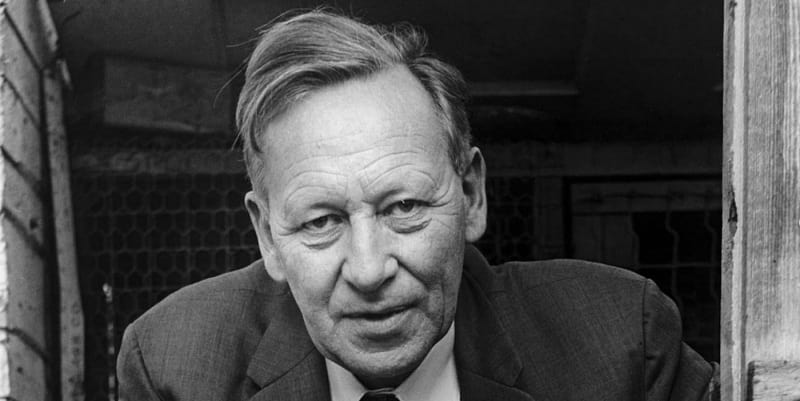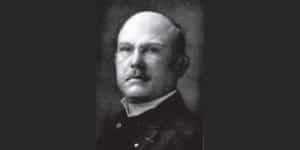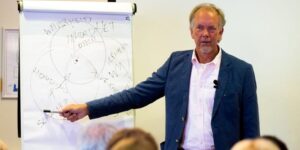Gregory Bateson biography and books

Gregory Bateson (May 9, 1904 – July 4, 1980) was an English anthropologist, scientist, linguist, semiotician, and cyberneticist. His most notable works include Steps to an Ecology of Mind (1972) and Mind (1972). Gregory Bateson had a strong interest in system theory, an interdisciplinary form of study and research. Each system has causal boundaries that are influenced by context and defined by structure, function, and role. He also developed the double-bind theory, a theory of schizophrenia and post-traumatic stress disorder and played a big role in the development of family therapy.
The biography of Gregory Bateson
Gregory Bateson was born in Grantchester, England in 1904. He was the third and youngest son of Caroline Beatrice Durham and geneticist William Bateson. He was named after Gregor Mendel, an Austrian monk who founded the modern science of genetics.
Young Bateson attended Charterhouse School between 1917 and 1921 and obtained a Bachelor of Arts in biology from St. John’s College, Cambridge, in 1925.
Bateson’s life was strongly influenced by the death of his two brothers, John Bateson and Martin Bateson. John tragically fell in World War I, and the second brother committed suicide, driven by a conflict with his father over the ambition to become a poet and playwright and a disappointment in love. After these events, the parents’ high expectations fell on Gregory’s shoulders.
Career of Gregory Bateson
From 1928, Gregory Bateson taught linguistics at the University of Sydney. From 1931 to 1937, he was a fellow of St. John’s College, Cambridge. During World War II, he was in the South Pacific, in Papua New Guinea, and Bali, where he mainly focused on anthropology. In the 1940s, Bateson worked mainly on expanding system theory and cybernetics to the social and behavioral sciences. He was initially reluctant to work for governments, but he eventually joined the Office of Strategic Services (OSS), one of the United States’ first intelligence services.
He spent much of the war designing propaganda radio broadcasts and was deployed on secret missions in Thailand, Burma, China, India, and Ceylon. He used his theories about human behavior to promote disagreement between his enemies. He later suffered greatly from his experiences in the war. He also disagreed with his wife about whether science should be used in the war or not.
In 1956, Gregory Bateson became a naturalized citizen of the United States. He was also one of the original members of the core group of the Macy Conferences on Cybernetics. In the 1970s, he taught at the Humanistic Psychology Institute in San Francisco, renamed the Saybrook University. In 1972, he joined the faculty of Kresge College at the University of California, Santa Cruz.
In 1976, he became a fellow of the American Academy of Arts and Sciences. He was also appointed a member of the Regents of the University of California by the governor of California, Jerry Brown.
Bateson spent the latter part of his life developing a metascience of epistemology to bring together various forms of system theory.
One of his famous theories, which he co-developed with Robert Dilts, are the logical levels: a theory about person changes and it’s affect on their behaviour.
Private Life
From 1936 to 1950, Gregory Bateson was married to anthropologist Margaret Mead, American of origin. Together they had a daughter, Mary Catherine Bateson, who also became an anthropologist. Bateson divorced Mead in 1950. A year later, he married Elizabeth Betty Sumner, a daughter of the Bishop of Oregon, Walter Taylor Sumner. They had a son, John Sumner Bateson, and a twin who died shortly after birth.
In 1957, Bateson divorced Sumner and married for the third time, this time to therapist and social worker Lois Cammack. They had a daughter, Nora Bateson. Bateson died on July 4, 1980. He lived to be 76 years old.
Bateson died at the San Francisco Zen Center’s pension. A novel was later written about his relationships and his time during World War II: Euphoria by Lily King, published in 2014.
Famous quotes
- “A major difficulty is that the answer to the Riddle of the Sphinx is partly a product of the answers that we already have given to the riddle in its various forms.”
- “A man walking is never in balance, but always correcting for imbalance.”
- “After mastery comes artistry and not before.”
- “All experience is subjective.”
- “But epistemology is always and inevitably personal. The point of the probe is always in the heart of the explorer: What is my answer to the question of the nature of knowing?”
- “Creative thought must always contain a random component.”
- “Every move we make in fear of the next war in fact hastens it.”
- “If we pursue this matter further, we shall be told that the stable object is unchanging under the impact or stress of some particular external or internal variable or, perhaps, that it resists the passage of time.”
- “In the transmission of human culture, people always attempt to replicate, to pass on to the next generation the skills and values of the parents, but the attempt always fails because cultural transmission is geared to learning, not DNA.”
- “Information is a difference that makes a difference.”
- “Interesting phenomena occur when two or more rhythmic patterns are combined, and these phenomena illustrate very aptly the enrichment of information that occurs when one description is combined with another.”
- “It is impossible, in principle, to explain any pattern by invoking a single quantity.”
- “It is of first-class importance that our answer to the Riddle of the Sphinx should be in step with how we conduct our civilisation, and this should in turn be in step with the actual workings of living systems.”
- “It is to the Riddle of the Sphinx that I have devoted fifty years of professional life as an anthropologist.”
- “It is, I claim, nonsense to say that it does not matter which individual man acted as the nucleus for the change. It is precisely this that makes history unpredictable into the future.”
- “It takes two to know one.”
- “Language commonly stresses only one side of any interaction.”
- “Logic can often be reversed, but the effect does not precede the cause.”
- “Logic is a poor model of cause and effect.”
- “Members of weakly religious families get, of course, no religious training from any source outside the family.”
- “Money is always transitively valued. More money is supposedly always better than less money.”
- “Number is different from quantity.”
- “Numbers are the product of counting. Quantities are the product of measurement. This means that numbers can conceivably be accurate because there is a discontinuity between each integer and the next.”
- “Official education was telling people almost nothing of the nature of all those things on the seashores, and in the redwood forests, in the deserts and in the plains.”
- “Play is the establishment and exploration of relationship.”
- “Rather, for all objects and experiences, there is a quantity that has optimum value. Above that quantity, the variable becomes toxic. To fall below that value is to be deprived.”
- “Science, like art, religion, commerce, warfare, and even sleep, is based on presuppositions.”
- “Surrender to alcohol intoxication provides a partial and subjective shortcut to a more correct state of mind.”
- “Synaptic summation is the technical term used in neurophysiology for those instances in which some neuron C is fired only by a combination of neurons A and B.”
- “The creature that wins against its environment destroys itself.”
- “The major problems in the world are the result of the difference between how nature works and the way people think.”
- “The meaning of your communication is the response you get.”
- “The only way out is spiritual, intellectual, and emotional revolution in which, finally, we learn to experience first-hand the interloping connections between person and person, organism and organism, action and consequence.”
- “There are times when I catch myself believing that there is such a thing as something; which is separate from something else.”
- “There is a strong tendency in explanatory prose to invoke quantities of tension, energy, and whatnot to explain the genesis of pattern. I believe that all such explanations are inappropriate or wrong.”
- “To think straight, it is advisable to expect all qualities and attributes, adjectives, and so on to refer to at least two sets of interactions in time.”
- “We can never be quite clear whether we are referring to the world as it is or to the world as we see it.”
- “We do not know enough about how the present will lead into the future.”
- “What is the pattern that connects the crab to the lobster and the primrose to the orchid, and all of them to me, and me to you?”
- “Wisdom is the intelligence of the system as a whole.”
- “Without context words and actions have no meaning at all.”
- “Yes, metaphor. That’s how the whole fabric of mental interconnections holds together. Metaphor is right at the bottom of being alive.”
Publications and books by Gregory Bateson et al.
- 2017. Communication: The social matrix of psychiatry. Routledge.
- 1989. The individual, communication, and society: Essays in memory of Gregory Bateson. Cambridge University Press.
- 1985. A timely rereading of Naven: Gregory Bateson as oracular essayist. Representations, 12, 66-82.
- 1975. Some components of socialization for trance. Ethos, 3(2), 143-155.
- 1972. The logical categories of learning and communication. Steps to an Ecology of Mind, 279-308.
- 1972. An ecology of mind. New York: Ballantine.
- 1971. The cybernetics of “self”: A theory of alcoholism. Psychiatry, 34(1), 1-18.
- 1971. A re-examination of “Bateson’s Rule”. Journal of Genetics, 60, 230-240.
- 1970. Form, substance and difference. Essential readings in biosemiotics, 501.
- 1970. Bali: The value system of a steady state. In Traditional Balinese Culture (pp. 384-402). Columbia University Press.
- 1967. Cybernetic explanation. American behavioral scientist, 10(8), 29-29.
- 1963. The role of somatic change in evolution. Evolution, 529-539.
- 1963. A note on the double bind- 1962. Family process, 2(1), 154-161.
- 1961. Perceval’s narrative: A patient’s account of his psychosis, 1830-1832.
- 1960. The group dynamics of schizophrenia.
- 1958. Naven: A survey of the problems suggested by a composite picture of the culture of a New Guinea tribe drawn from three points of view (Vol. 21). Stanford University Press.
- 1956. Toward a theory of schizophrenia. Behavioral science, 1(4), 251-264.
- 1955. A theory of play and fantasy. Psychiatric research reports.
- 1942. Morale and national character.
- 1942. Balinese character: A photographic analysis. New York, 17-92.
- 1941. IV. The frustration-aggression hypothesis and culture. Psychological Review, 48(4), 350.
- 1941. Experiments in thinking about observed ethnological material. Philosophy of Science, 8(1), 53-68.
- 1935. 199. culture contact and schismogenesis. Man, 178-183.
- 1932. Social structure of the Iatmül people of the Sepik River (concluded). Oceania, 2(4), 401-453.
How to cite this article:
Janse, B. (2023). Gregory Bateson. Retrieved [insert date] from Toolshero: https://www.toolshero.com/toolsheroes/gregory-bateson/
Published on: 04/04/2023 | Last update: 08/23/2023
Add a link to this page on your website:
<a href=”https://www.toolshero.com/toolsheroes/gregory-bateson/”>Toolshero: Gregory Bateson</a>











